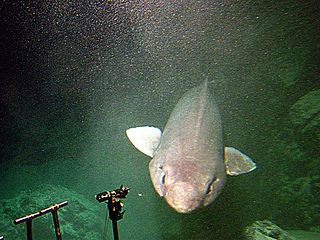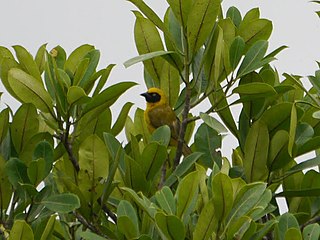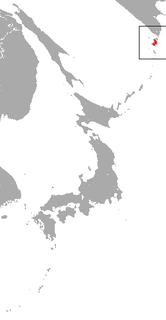
The conservation status of a group of organisms indicates whether the group still exists and how likely the group is to become extinct in the near future. Many factors are taken into account when assessing conservation status: not simply the number of individuals remaining, but the overall increase or decrease in the population over time, breeding success rates, and known threats. Various systems of conservation status exist and are in use at international, multi-country, national and local levels as well as for consumer use.
Salangidae, the icefishes or noodlefishes, are a family of small osmeriform fish, related to the smelts. They are found in Eastern Asia, ranging from the Russian Far East in the north to Vietnam in the south, with the highest species richness in China. Some species are widespread and common, but others have relatively small ranges and are threatened. Depending on species, they inhabit coastal marine, brackish or fresh water habitats, and some are anadromous, only visiting fresh water to spawn.

The New Guinea big-eared bat or Papuan big-eared bat,, is a vespertilionid bat endemic to Papua New Guinea. It is listed as a critically endangered species due to ongoing habitat loss. It is the only known member of the genus Pharotis, which is closely related to Nyctophilus.

The false catshark or sofa shark is a species of ground shark in the family Pseudotriakidae, and the sole member of its genus. It has a worldwide distribution, and has most commonly been recorded close to the bottom over continental and insular slopes, at depths of 500–1,400 m (1,600–4,600 ft). Reaching 3.0 m (9.8 ft) in length, this heavy-bodied shark can be readily identified by its elongated, keel-like first dorsal fin. It has long, narrow eyes and a large mouth filled with numerous tiny teeth. It is usually dark brown in color, though a few are light gray.

Notiosorex cockrumi, also called Cockrum's gray shrew or Cockrum's desert shrew, is a tiny species of shrews named in 2003. This red-toothed shrew, which is as light as a penny, is the first new mammal species from Arizona since 1977. Its range extends from Arizona to central Sonora, Mexico.

A species that is extinct in the wild (EW) is one that has been categorized by the International Union for Conservation of Nature as known only by living members kept in captivity or as a naturalized population outside its historic range due to massive habitat loss.

The chocolate wattled bat, species Chalinolobus morio, is a bat allied to the family Vespertilionidae. It is found only in Australia, including the island Tasmania, and widespread in southern regions. It is known to reside from sea level to at least 1,570 metres (5,150 ft) in Victoria.

The small-toothed long-eared bat, species Nyctophilus microdon, is a vespertilionid bat. This flying mammal is found only in Papua New Guinea.
The small Luzon forest mouse is a species of rodent in the family Muridae. It is found only in the Philippines.
The small-toothed harvest mouse is a species of rodent in the family Cricetidae. It is found in Guatemala and Mexico.

Bannerman's weaver is a species of bird in the weaver family, Ploceidae. It is found in Cameroon and Nigeria. Its natural habitat is subtropical or tropical moist montane forests. It is threatened by habitat loss.

The small-toothed sportive lemur, or small-toothed weasel lemur, is a primate species in the family Lepilemuridae that—like all extant lemurs—is endemic to Madagascar. The species lives in dense rainforest in southeastern Madagascar, and can be found in Ranomafana and Andringitra National Parks. Described in 1894, it was considered either a subspecies or taxonomic synonym of the weasel sportive lemur throughout most of the 20th century. Phylogenetic studies not only support its species status, but also suggest that it is the only eastern Malagasy sportive lemur that is more closely related to western than to other eastern species.

The Somali hedgehog is a species of mammal in the family Erinaceidae. It is endemic to Somalia and Somaliland. The Somali hedgehog is nocturnal.

The Bornean water shrew is a species of mammal in the family Soricidae. It is endemic to Malaysia. Its natural habitat is rivers. It is threatened by habitat loss.

The Ugandan lowland shrew is a species of mammal in the family Soricidae. It is found in Kenya and Uganda. Its natural habitats are subtropical or tropical swamps and subtropical or tropical moist montane forest. It is threatened by habitat loss.

The Paramushir shrew is a species of mammal in the family Soricidae. It is endemic to Russia. Its natural habitat is temperate forests. It is threatened by habitat loss.

Day's shrew is a species of mammal in the family Soricidae. It is endemic to India. Its natural habitat is subtropical or tropical dry forests. It is threatened by habitat loss.

Haplochromis microdon is a species of cichlid endemic to Lake Victoria though it may now be extinct. This species can reach a length of 14.8 centimetres (5.8 in) SL.
Lethrinops microdon is an endangered species of cichlid endemic to the southern part of Lake Malawi where it occurs at depths of 35 to 100 metres in areas with soft substrates. This species grow to a length of 13.1 centimetres (5.2 in) SL. The species is threatened by trawl fisheries and has greatly declined but little is known about its population and distribution within Lake Malawi, it is given a status of Data Deficient by the IUCN.















